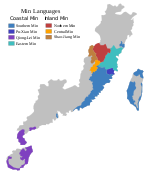| Shao–Jiang | |
|---|---|
| 邵將 / 邵将 | |
| Native to | Southern China |
| Region | western Nanping Prefecture, Fujian |
| Native speakers | 850,000 (2004) |
| Language family | Sino-Tibetan
|
| Early forms | Proto-Sino-Tibetan |
| Dialects | |
| Writing system | Chinese characters, Romanized Shaowu (Shaowu dialect) |
| Language codes | |
| ISO 639-3 | sjc |
| Glottolog | shao1234 |
| Linguasphere | > 79-AAA-la 79-AAA-l > 79-AAA-la |
 Shao–Jiang Min Shao–Jiang Min | |
Shao–Jiang or Shaojiang Min (simplified Chinese: 邵将; traditional Chinese: 邵將; pinyin: Shàojiāng) is a Min Chinese language centered on Western Nanping in Northwest Fujian, specifically in the Nanping counties of Guangze, Shaowu, and Western Shunchang and the Northern Sanming county of Jiangle.
Shao–Jiang developed from Northern Min (Min Bei), and was deeply influenced by Gan Chinese and Hakka Chinese. The classification of Shao–Jiang is disputed. It is frequently classified as a variety of Northern Min, but sometimes it is excluded from Min and classified as Gan Chinese instead. But it is mutually intelligible with neither other Northern Min nor other Gan. Actually it is a collection of dialects which have limited mutual intelligibility with each other instead of a coherent language. Some Chinese scholars call them Min-Gan varieties (闽赣方言), Min-Gan transitional varieties (闽赣过渡方言) or Min-Hakka-Gan transitional varieties (闽客赣过渡方言).
Notes
- Min is believed to have split from Old Chinese, rather than Middle Chinese like other varieties of Chinese.
References
- Language atlas of China (2nd edition), City University of Hong Kong, 2012, ISBN 978-7-10-007054-6.
- Mei, Tsu-lin (1970), "Tones and prosody in Middle Chinese and the origin of the rising tone", Harvard Journal of Asiatic Studies, 30: 86–110, doi:10.2307/2718766, JSTOR 2718766
- Pulleyblank, Edwin G. (1984), Middle Chinese: A study in Historical Phonology, Vancouver: University of British Columbia Press, p. 3, ISBN 978-0-7748-0192-8
- Hammarström, Harald; Forkel, Robert; Haspelmath, Martin; Bank, Sebastian (2023-07-10). "Glottolog 4.8 - Min". Glottolog. Leipzig: Max Planck Institute for Evolutionary Anthropology. doi:10.5281/zenodo.7398962. Archived from the original on 2023-10-13. Retrieved 2023-10-13.
- Min Shaojiang dialect classification at Glossika
This Sino-Tibetan languages-related article is a stub. You can help Misplaced Pages by expanding it. |
| Sino-Tibetan branches | |||||
|---|---|---|---|---|---|
| Western Himalayas (Himachal, Uttarakhand, Nepal, Sikkim) |
|  | |||
| Eastern Himalayas (Tibet, Bhutan, Arunachal) | |||||
| Myanmar and Indo- Burmese border |
| ||||
| East and Southeast Asia |
| ||||
| Dubious (possible isolates) (Arunachal) |
| ||||
| Proposed groupings | |||||
| Proto-languages | |||||
| Italics indicates single languages that are also considered to be separate branches. | |||||
| Min Chinese | ||||||||||||||||||||||||||||||||||
|---|---|---|---|---|---|---|---|---|---|---|---|---|---|---|---|---|---|---|---|---|---|---|---|---|---|---|---|---|---|---|---|---|---|---|
| ||||||||||||||||||||||||||||||||||
| ||||||||||||||||||||||||||||||||||
| ||||||||||||||||||||||||||||||||||
| Chinese language | ||||||||||||||||||||||||||||||||||||||||||||||||||||||||||||||||||||||||||||||||
|---|---|---|---|---|---|---|---|---|---|---|---|---|---|---|---|---|---|---|---|---|---|---|---|---|---|---|---|---|---|---|---|---|---|---|---|---|---|---|---|---|---|---|---|---|---|---|---|---|---|---|---|---|---|---|---|---|---|---|---|---|---|---|---|---|---|---|---|---|---|---|---|---|---|---|---|---|---|---|---|---|
| Sinitic languages | ||||||||||||||||||||||||||||||||||||||||||||||||||||||||||||||||||||||||||||||||
| Major groups |
|  | ||||||||||||||||||||||||||||||||||||||||||||||||||||||||||||||||||||||||||||||
| Standard forms | ||||||||||||||||||||||||||||||||||||||||||||||||||||||||||||||||||||||||||||||||
| Phonology | ||||||||||||||||||||||||||||||||||||||||||||||||||||||||||||||||||||||||||||||||
| Grammar | ||||||||||||||||||||||||||||||||||||||||||||||||||||||||||||||||||||||||||||||||
| Idioms | ||||||||||||||||||||||||||||||||||||||||||||||||||||||||||||||||||||||||||||||||
| Input | ||||||||||||||||||||||||||||||||||||||||||||||||||||||||||||||||||||||||||||||||
| History | ||||||||||||||||||||||||||||||||||||||||||||||||||||||||||||||||||||||||||||||||
| Literary forms |
| |||||||||||||||||||||||||||||||||||||||||||||||||||||||||||||||||||||||||||||||
| Scripts |
| |||||||||||||||||||||||||||||||||||||||||||||||||||||||||||||||||||||||||||||||
